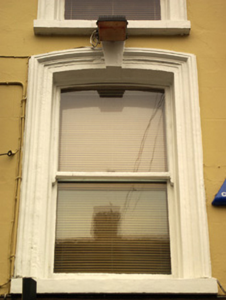Survey Data
Reg No
40843022
Rating
Regional
Categories of Special Interest
Architectural
Original Use
House
In Use As
House
Date
1860 - 1890
Coordinates
193005, 378420
Date Recorded
23/11/2007
Date Updated
--/--/--
Description
Attached two-bay three-storey house, built c. 1875, having former retail outlet at ground floor level with tiled shopfront c. 1970. Possibly built as a pair with the building adjoining to the east (not in survey). Pitched natural slate roof with smooth rendered chimneystacks to either end (east and west). Cast-iron downpipe with hopper and replacement gutters. Smooth rendered ruled-and-lined walls to upper floors. Shallow segmental- headed window openings to upper floors having rendered architrave surrounds, stone sills, and one-over-one horned timber sash windows. Keystone detail to first floor windows. Square-headed door opening to the east end of the main elevation (south) with replacement timber panelled door and glazed overlight. Shopfront to ground floor with tiled walling, timber fascia board with raised lettering, central recessed square-headed doorway, and fixed-pane display windows. Large projecting double-faced clock to first storey. Fronts directly onto street to the west end of Lower Main Street, and short distance from The Diamond at the centre of Donegal Town.
Appraisal
This simple terraced building retains its original form and character to the upper floors. Its architectural integrity is enhanced by the retention of features such as the timber sliding sash windows and the slate roof, while the heavy architraved surrounds to the window openings at upper floor level adds a decorative element to the otherwise plain front elevation. It displays classical proportions in the diminishing windows to its façade. Buildings of this type were, until recently, a ubiquitous feature of Irish towns but are now becoming increasingly rare due to alteration and demolition. The modern tiled shopfront detracts somewhat from its appearance at ground floor level. The proportions and scale of this building, and the detailing to the upper floors suggests that it dates to the second half of the nineteenth century. The form of the building adjacent to the east (now heavily altered) hints that these buildings may have been built as a pair. This building is a modest addition to the built heritage of Donegal Town, and makes a positive contribution to the streetscape towards the centre of the town.





